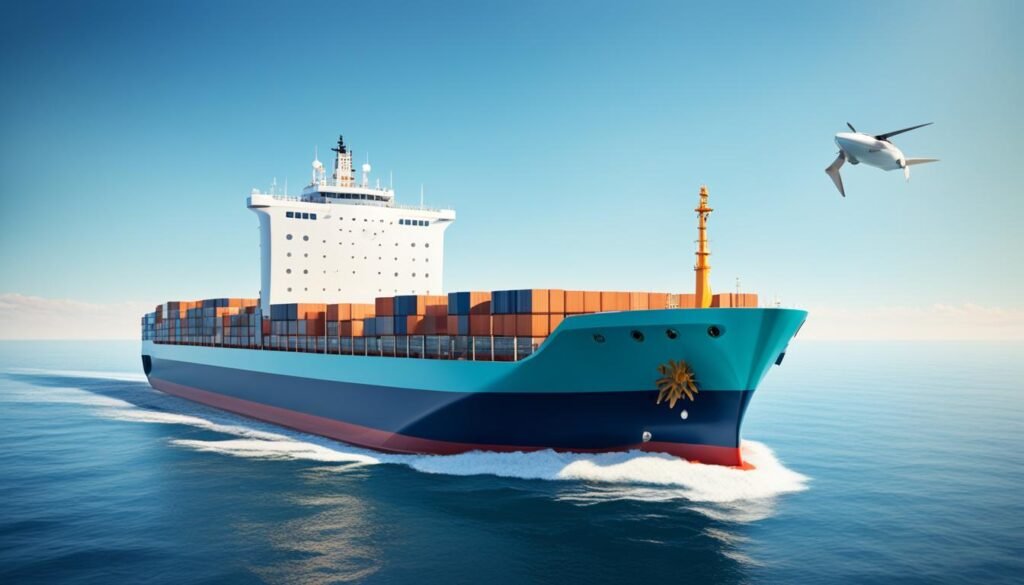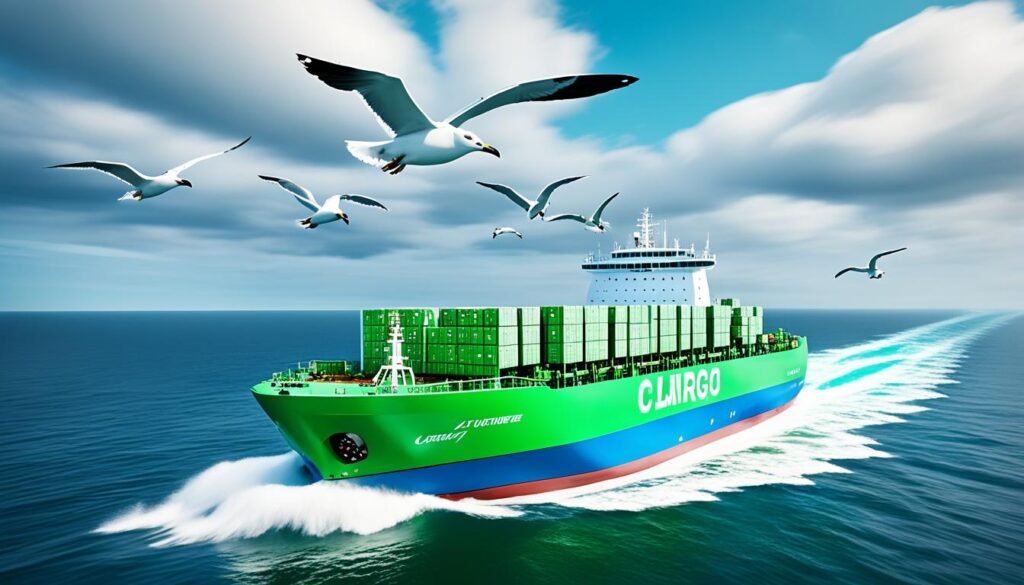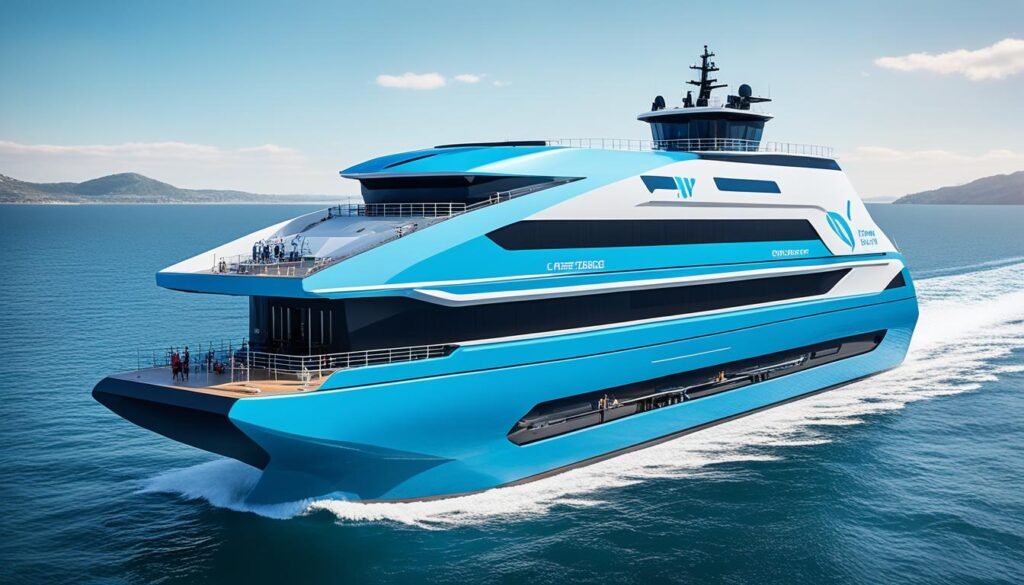As I look out at the busy harbor, I see cargo ships moving across the water. These huge ships are key to the world’s economy but also harm the environment. What if we could use new technology to make them cleaner and more sustainable?
The move to electric power in the shipping world is exciting. It could change how we transport goods, which is crucial for our economies. Ships are a big part of the problem, making up a quarter of all greenhouse gas emissions. Now, there’s a push to make them electric to cut down on pollution.
Every year, 11 billion tons of goods move by ship, and the value of global shipping hit over $14 trillion in the last couple of years. Making ships electric means switching from old fuel to electric systems. This includes using electric propulsion systems and renewable energy.

The Rise of Electric Propulsion in the Maritime Industry
The maritime industry is changing fast, with electric ships leading the way. These ships use marine electric propulsion systems and renewable energy like wind and solar. This shift is a big step towards cleaner seas.
Electrification: A Revolution in Marine Transportation
Electric ships are becoming more common, especially for ferries and small cargo ships. They cut down on emissions and meet environmental rules. They also have less noise, are more efficient, are easier to move, and cost less to keep up.
The move to electric propulsion in cargo ships is driven by strict rules to cut down on greenhouse gases. It’s also pushed by better battery and renewable energy tech. Plus, the industry wants to be more sustainable.
The Environmental and Economic Benefits of Electric Propulsion
Electric propulsion systems in cargo ships are great for the planet and your wallet. They don’t emit greenhouse gases, helping to lower the industry’s carbon footprint. Plus, they’re more energy efficient, which means lower costs and better handling.

The maritime world is changing, with electric ships at the forefront thanks to tech and eco-awareness. Switching to electric ships marks a big move towards a sustainable and green maritime transportation future. It’s in line with global efforts to be more sustainable and innovative.
Electric Propulsion in Cargo Ships: Meeting the Sustainability Challenge
Using electric and hybrid propulsion in cargo ships is key to making the maritime industry more sustainable. These hybrid electric vessels cut down on emissions and make shipping more fuel-efficient. They also lower costs, making them a smart choice for moving goods.
Switching to alternative marine fuels like biofuels and hydrogen is vital for the industry. It helps meet decarbonizing maritime sector goals and follows stricter environmental rules.
Battery-powered vessels and other zero-emission shipping options greatly reduce carbon emissions. By moving away from diesel engines, cargo ships can help the industry meet its emission goals.
| Metric | Value |
|---|---|
| Market size of the integrated all-electric propulsion system for ships | $XX million (2021) |
| The shipping industry’s carbon dioxide (CO2) emissions projected to account for | XX% (2021-2026) |
| The shipping industry’s carbon dioxide (CO2) emissions are projected to account for | 12–18% of worldwide CO2 emissions by 2050 |
Switching to electric and hybrid propulsion has its hurdles, though. High upfront costs, limited electric ship infrastructure, and doubts about electric propulsion reliability are some issues. Yet, the advantages of hybrid electric vessels and zero-emission shipping make them a strong choice for the industry’s future.

Overcoming Technological Barriers
Switching to electric propulsion in cargo ships has faced many tech challenges. But, new battery tech and energy storage solutions are slowly solving these issues. The main problem was the limited power and range of current batteries. Now, better lithium-ion batteries and fuel cell tech are making marine electric motors and battery-powered cargo ships more popular.
Advancements in Battery Technology and Energy Storage Solutions
New battery tech has boosted the power and capacity of lithium-ion batteries. This makes them better for bigger cargo ships. These improvements, along with new energy storage solutions, are key for electric and hybrid systems in shipping. This is why we’re seeing more sustainable shipping technology and green maritime logistics.
Vard Electro is leading the way with fully electric service operation vessels (SOVs) and offshore charging stations. These will support zero-emission work at offshore wind farms. The first all-electric ferry, Norled’s Ampere, has been running since 2015. It shows how well lithium-ion battery power and fuel cell technology work in shipping.
Starting in 2024, offshore vessels will be part of the EU Emissions Trading System (EU ETS). This will push for more battery-powered cargo ships and the use of alternative marine fuels. This will cut emissions and make shipping more sustainable.
| Technological Advancements | Benefits |
|---|---|
| Improved lithium-ion battery energy density and capacity | Increased range and power for battery-powered cargo ships |
| Development of innovative energy storage solutions | Enablement of scaling electric and hybrid propulsion systems |
| Offshore charging solutions for electric service operation vessels | Facilitation of zero-emission maintenance operations at offshore wind farms |
| Increased uptake of alternative marine fuels like methanol | Reduction of emissions and improved sustainability in the shipping industry |
Electric Propulsion in Cargo Ships: A Growing Trend
The maritime industry is changing fast, with electric propulsion in cargo ships becoming more popular. This change is driven by the need to cut emissions and improve fuel efficiency. Cargo ship operators are now using new propulsion technologies like hybrid electric systems and battery-powered vessels.
Recently, over 1GWh of batteries started working in cargo ships around the world. This shows a 72% increase in electric propulsion in 2022. Electric ferries made up 37% of all battery capacity delivered from 2019 to 2022. Norway leads with about 100 electric ferries, the most in the world.
Switching to electric propulsion helps with environmental concerns and brings big benefits. Hybrid propulsion technology can cut fuel use by almost 20% and reduce CO2 emissions by up to 15%. This makes it a key player in the electric ship market.
Advances in battery technology and energy storage solutions are making electric cargo ships more efficient. IDTechEx predicts more electric cargo ship deals coming up. This is thanks to new rules and bigger battery systems becoming available.
The global electric ship market is set to grow from $4.33 billion in 2024 to $17.20 billion by 2032. This means an 18.8% growth rate over the forecast period. This growth is thanks to the industry’s push for maritime decarbonization strategies and using alternative fuel technologies.
The use of electric propulsion in cargo ships shows the industry’s commitment to being green and efficient. It’s a sign of the industry’s innovative spirit and its aim for green shipping initiatives and emission-free vessels.
You can refer to this article on Electric Propulsion System for Ship: Does it have a Future in the Shipping? for more information.
Shore Power and Port Infrastructure: Enabling Electrification
The use of electric propulsion systems in cargo ships needs strong shore power and port facilities. Shore power, or cold ironing, connects ships to land power while docked. This cuts down on air pollution and noise in ports.
Having shore power and renewable energy in ports helps hybrid-electric propulsion for ships and emission-free shipping solutions grow. Hybrid ship engines and electrified fleets need this shore-side setup to recharge and be more eco-friendly.
| Key Insights | Statistics |
|---|---|
| Cavotec has equipped over 1,000 ships with its shore power systems in the past two decades, with nearly 70% being container ships. A single container ship at port may require up to 7.5 MVA of electricity to power its equipment and cargo, such as reefer containers. Shore power projects typically take 3 to 4 years from feasibility studies to vessel connection. Connecting to shore power can reduce fuel consumption and emissions by as much as 10% depending on the vessel type and trade. | Cavotec has supplied electrical socket boxes to more than 40 container terminals worldwide. Wabtec offers various cable management solutions for providing shore power to vessels, such as cable reels, junction boxes, and moveable solutions. By 2030, all container and passenger ships will be required to connect to shore power when in a Trans-European Network port for more than two hours. Wärtsilä has installed shore power solutions on 150 vessels worldwide. |
Shore power has been around for over 20 years but is still growing in the maritime world. It faces challenges like long project times and the need for global standards. Yet, building shore power and using renewable energy in ports is key to making electric ship propulsion systems and alternative fuel propulsion technologies common in cargo shipping.
Regulatory Framework and Policies
The rules and policies for the maritime industry are key to making hybrid ship propulsion, maritime decarbonization, and green shipping technology more common. Groups like international organizations, national policymakers, and industry leaders are working together. They aim to make emission-free cargo vessels and energy-efficient shipping solutions the norm.
They’re setting emissions reduction goals, creating fuel efficiency standards, and offering rewards for new ship electrification and alternative maritime propulsion systems. These include lithium-ion batteries, hydrogen fuel cells, and electric motors. They’re also improving the infrastructure, like shore power and energy storage solutions, to help these emission-free and energy-efficient shipping technologies spread out more.
This united effort is crucial for making electric propulsion in cargo ships more common. It will help the maritime industry become more decarbonized. By matching rules and policies with the latest in green shipping technology, the maritime sector can move faster towards a sustainable and eco-friendly future.
| Propulsion System | Zero-Emission Operation | Emissions Reduction |
|---|---|---|
| Parallel Hybrid | Minor Reductions | Potentially Higher Emissions |
| Series Hybrid | 30-99% of the Time | Significant Reductions |
| Full Electric | 100% of the Time | Zero Emissions |
Conclusion
The move to electric cargo ships is a big step towards a greener future for the maritime industry. By using electric and hybrid systems, the industry is getting cleaner and more efficient. This change is happening thanks to new technology and rules.
As tech improves, like better batteries and storage, electric cargo ships are set to shine. New ideas like pod-type propulsion and superconducting technology are making ships more efficient. These innovations are key to a greener future at sea.
Together, groups like the International Maritime Organization, policymakers, researchers, and companies are leading the way. They aim for a shipping industry that’s low on carbon, good for the planet, and makes sense financially. By focusing on reducing emissions and using green tech, the shipping world can meet environmental goals. This will help make the future of the sea cleaner and more sustainable.
FAQ
What is the electrification of the maritime industry?
The electrification of the maritime industry means switching from traditional fossil fuels to electric systems. This includes using electric propulsion and renewable energy sources.
What are the benefits of electric propulsion systems in cargo ships?
Electric propulsion in cargo ships cuts down on greenhouse gas emissions and boosts energy efficiency. It also lowers operating costs and makes ships more maneuverable.
What are the technological barriers to the widespread adoption of electric propulsion in cargo ships?
The main hurdles are the current limitations of battery technology and energy storage solutions. Improvements in lithium-ion batteries and fuel cell technology are key to making electric propulsion work in larger ships.
How does shore power infrastructure support the electrification of cargo ships?
Shore power lets ships connect to land-based electricity while docked. This means they can turn off their engines and use shore power. It cuts down on air pollution and noise in ports, making electric and hybrid ships more viable.
What is the role of regulatory frameworks and policies in driving the adoption of electric propulsion in cargo ships?
Rules and policies are vital in pushing for electric propulsion in cargo ships. Groups like international organizations and national policymakers are working to support clean and efficient technologies in shipping.
You can also read these blog post
